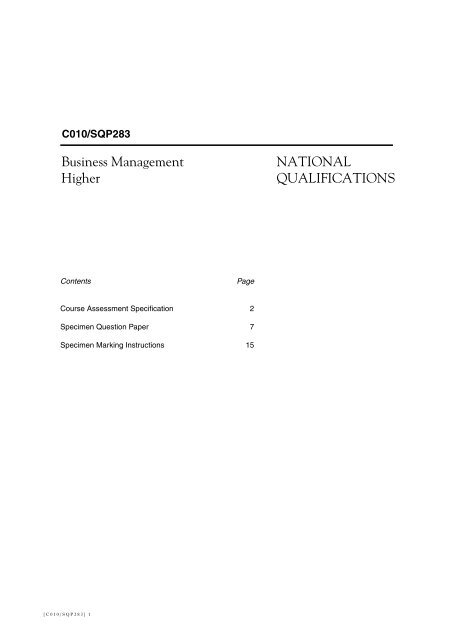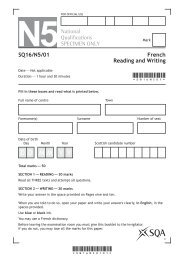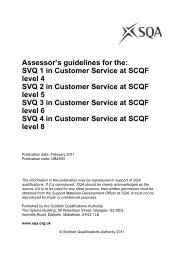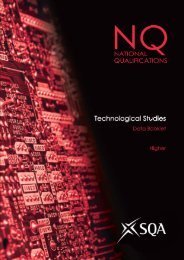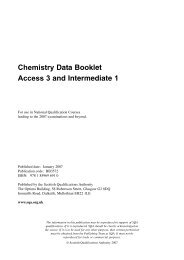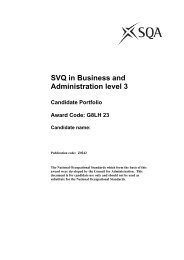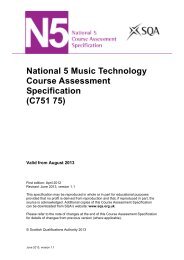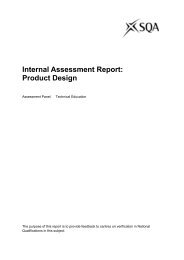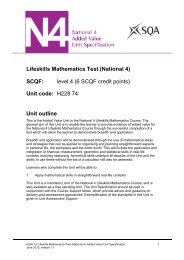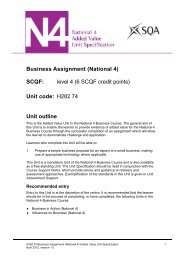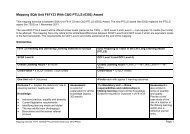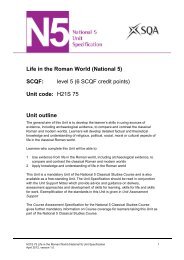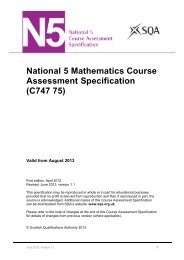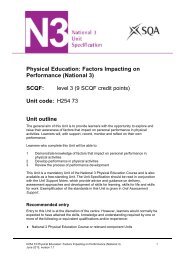Higher Business Management Course Specimen Question ... - SQA
Higher Business Management Course Specimen Question ... - SQA
Higher Business Management Course Specimen Question ... - SQA
You also want an ePaper? Increase the reach of your titles
YUMPU automatically turns print PDFs into web optimized ePapers that Google loves.
C010/SQP283<br />
<strong>Business</strong> <strong>Management</strong><br />
<strong>Higher</strong><br />
NATIONAL<br />
QUALIFICATIONS<br />
Contents<br />
Page<br />
<strong>Course</strong> Assessment Specification 2<br />
<strong>Specimen</strong> <strong>Question</strong> Paper 7<br />
<strong>Specimen</strong> Marking Instructions 15<br />
[C010/SQP283] 1
<strong>Course</strong> Assessment Specification<br />
<strong>Business</strong> <strong>Management</strong> <strong>Higher</strong><br />
The purpose of this document is to provide:<br />
♦ Details of the structure of the <strong>Question</strong> Paper in this <strong>Course</strong><br />
♦ Guidance to centres on how to use information gathered from the <strong>Question</strong> Paper<br />
in this <strong>Course</strong> to estimate candidate performance<br />
Part 1<br />
This part of the <strong>Course</strong> Assessment Specification details the structure of the<br />
<strong>Question</strong> Paper in this <strong>Course</strong>.<br />
<strong>Course</strong> Assessment<br />
The <strong>Course</strong> assessment is a <strong>Question</strong> Paper.<br />
Paper Time allocation Mark allocation<br />
1 2 hours 30 minutes 100<br />
♦ The paper examines knowledge and understanding covering the <strong>Course</strong> content<br />
and also assesses problem solving and decision making in a business context.<br />
♦ The paper will consist of two sections.<br />
♦ Section One will contain questions on the interpretation of a case study of a<br />
business while Section Two will be extended response questions.<br />
♦ <strong>Question</strong>s in both sections may focus on particular areas of <strong>Course</strong> content but<br />
there will also be questions which provide an opportunity to integrate topics across<br />
all areas of the <strong>Course</strong> content. These integrative questions may cover topics from<br />
any area of the three Units which comprise the <strong>Course</strong>.<br />
Section One – total marks available 50<br />
This section of the paper will assess knowledge and understanding, problem solving<br />
and decision making.<br />
It will consist of a case study of a business organisation with a number of<br />
interpretation questions totalling 50 marks. There will be a combination of short<br />
answer questions and questions requiring a more extended response. Candidates will<br />
be expected to attempt all questions. Candidates may be required to assume a<br />
management position and make decisions necessary to solve problems.<br />
The case study will be about 750 words long and will explain a situation facing an<br />
organisation or organisations. It will be based on a real organisation. There will be a<br />
number of mandatory questions related to it and candidates may be required to assume<br />
a management position and make decisions necessary to solve problems.<br />
[C010/SQP283] 2 Page 2
The questions will ask candidates to do one or more of the following:<br />
♦ analyse the information given and identify the problems<br />
♦ identify and assess constraints<br />
♦ devise solutions and make recommendations<br />
♦ justify their recommendations.<br />
Section Two – total marks available 50<br />
This section of the paper will assess knowledge and understanding.<br />
♦ It will consist of five questions drawn from any part of the <strong>Course</strong> content.<br />
♦ Candidates should attempt any two questions.<br />
♦ Each question will require extended answers and will be worth 25 marks.<br />
♦ <strong>Question</strong>s may be divided into two or more parts.<br />
Relationship between Unit and <strong>Course</strong> assessment<br />
The Unit assessments sample the knowledge and understanding gained during the<br />
learning and teaching progress. Each Unit assessment is self-contained and covers<br />
only the content relevant to that Unit. A significant purpose of the Unit assessment<br />
is to enable candidates to demonstrate that they have grasped the essential aspects of<br />
business management introduced during the Unit. They do allow candidates to apply<br />
their knowledge and understanding but in contexts which are familiar to them. As<br />
such, the Unit assessments provide an on-going benchmark against which candidates<br />
can measure their progress.<br />
The <strong>Course</strong> assessment samples all aspects of the <strong>Course</strong> content and thus covers<br />
material from all three Units. In addition, the <strong>Course</strong> assessment may sample from<br />
the section of the <strong>Course</strong> content on ‘Internal Organisation’ which is not associated<br />
with any of the three Unit specifications. It tests knowledge and understanding and<br />
includes problem solving and decision making relating to a case study of a business.<br />
It also requires integration of topics from more than one Unit and tests retention of<br />
material to a greater extent than the Unit assessments. Candidates are expected to<br />
adopt a more analytical, problem solving approach than for the Unit assessments.<br />
The different emphasis of the Unit and <strong>Course</strong> assessments will ensure that there is no<br />
unnecessary duplication of assessment. On occasions, it is possible that the same<br />
topic may feature in both assessments but candidates will be expected to carry<br />
forward the knowledge and understanding of a specific topic from the Units and apply<br />
it in unfamiliar contexts and/or in association with other topics in an integrative way.<br />
[C010/SQP283] 3 Page 3
The ‘added value’ of the <strong>Course</strong><br />
The Unit and the <strong>Course</strong> assessments complement each other. Candidates may<br />
undertake Units on a stand-alone basis. The holistic approach to Unit assessment<br />
means that those who take this route will be able to demonstrate specific achievement<br />
in a particular area of <strong>Business</strong> <strong>Management</strong> within a familiar context. Candidates<br />
who undertake the <strong>Course</strong> will have additional demands imposed upon them which<br />
will enable them to gain significant benefits over and above those gained completing<br />
the Units.<br />
The additional demands will require candidates to:<br />
♦ demonstrate the retention of knowledge from all areas of the <strong>Course</strong> content<br />
♦ integrate knowledge and understanding from all areas of the <strong>Course</strong> content<br />
♦ respond to questions relating to unfamiliar and more complex contexts<br />
♦ adopt a problem solving and decision making approach to a business situation set<br />
in an unfamiliar and more complex context<br />
The additional 40 hours for the <strong>Course</strong> is to allow these additional demands to be met.<br />
It also gives those delivering the <strong>Course</strong> the opportunity to make use of a wide range<br />
of teaching and learning strategies to assist candidates in meeting these additional<br />
demands.<br />
[C010/SQP283] 4 Page 4
Part 2<br />
This part of the <strong>Course</strong> Assessment Specification provides guidance on how to<br />
use assessment information gathered from the <strong>Question</strong> Paper to estimate<br />
candidate performance.<br />
The <strong>Course</strong> award is based on the total mark gained in the <strong>Question</strong> Paper.<br />
In National Qualifications cut-off scores should be set at approximately 70% for<br />
Grade A and 50% for Grade C with Grade B falling midway.<br />
For a total mark range of 0 – 100, the following gives an indication of the cut-off<br />
scores:<br />
Grade Band Mark Range<br />
A 1 85 – 100<br />
A 2 70 – 84<br />
B 3 65 – 69<br />
B 4 60 – 64<br />
C 5 55 – 59<br />
C 6 50 – 54<br />
D 7 45 – 49<br />
NA 8 40 – 44<br />
NA 9 0 - 39<br />
These cut-off scores may be lowered if the <strong>Question</strong> Paper is more demanding or<br />
raised if the <strong>Question</strong> Paper is less demanding than the standard set by <strong>SQA</strong>.<br />
Worked example<br />
A candidate scores 62/100 in a centre’s own prelim. In estimating performance for<br />
this candidate, the centre might apply the following considerations.<br />
♦ The centre’s view is that the prelim is slightly less demanding than the question<br />
paper in the <strong>SQA</strong> examination.<br />
♦ Using the table, a realistic estimate of the candidate’s performance in the <strong>SQA</strong><br />
examination may be band 5 rather than band 4.<br />
[C010/SQP283] 5 Page 5
[C010/SQP283] 6<br />
PagePa
C010/SQP283<br />
<strong>Business</strong><br />
<strong>Management</strong><br />
<strong>Higher</strong><br />
<strong>Specimen</strong> <strong>Question</strong> Paper<br />
for use in and after 2006<br />
Time: 2 hours 30 mins<br />
NATIONAL<br />
QUALIFICATIONS<br />
Candidates should attempt all questions in Section One and two questions from Section Two.<br />
Read all the questions carefully.<br />
100 marks are allocated to this paper.<br />
50 marks for Section One and<br />
50 marks for Section Two.<br />
Answers are to be written in the answer book provided.<br />
[C010/SQP283] 7<br />
©
SECTION ONE<br />
This section should take you approximately 1 hour 15 minutes.<br />
Read through the following information, then answer the questions which follow.<br />
GLAXOSMITHKLINE (GSK) LEAVES MONTROSE<br />
GSK is a multinational pharmaceutical (drug) company and the<br />
present structure is a result of a merger in 2000 between Glaxo<br />
Wellcome and Smithkline Beecham. In 2004 Glaxosmithkline (GSK)<br />
announced the planned closure of its plant in Montrose.<br />
CANDIDATE’S<br />
NOTES<br />
BACKGROUND TO THE CLOSURE<br />
At the time of the merger over 2000 job<br />
losses were predicted in the UK,<br />
including closure of the Montrose plant.<br />
This was to streamline its operations<br />
function, eliminating the duplication of<br />
some processes. Another plant in England<br />
was also selected for closure. The asthma<br />
inhalers this plant produced were shown<br />
to contain CFC gases and this is against<br />
environmentally friendly policies.<br />
Shareholders were informed that savings<br />
of £750 million a year would result.<br />
It was reported that there was a lot of interest in purchasing the<br />
Scottish plant. The Dutch Chemical Group Azko Nobel made an<br />
offer. Unfortunately the deal collapsed due to changed economic<br />
circumstances with a projected fall in profits of more than 10%.<br />
Further bad news regarding the Montrose plant came in a newspaper<br />
article where it was reported that no new orders were being placed<br />
and there were no new products in the pipeline.<br />
[C010/SQP283] 8<br />
Page two
THE PRODUCTS<br />
GSK produce bulk chemicals in Montrose providing ingredients for<br />
medicines given for respiratory problems, skin conditions, highly<br />
infectious diseases and cancer. The patents of some of these<br />
treatments were approaching their expiry date when the closure was<br />
proposed. A patent is a legal right which allows an organisation to<br />
stop people from making, using or selling your invention without<br />
your permission. A patent can remain in force for up to 20 years.<br />
Despite the age of GSK’s patents a buyer of the Montrose plant<br />
would have inherited a contract to make ingredients for 8 GSK<br />
products said to be worth £1 billion a year. This would provide<br />
sufficient work for 300 employees. To maintain the plant’s viability<br />
a new owner would have to transfer some of its own business to<br />
Montrose.<br />
GSK also face problems abroad with patents. Enforcing patents in<br />
China and India is difficult and competitors copying products have<br />
proved to be a problem. It is reported that if India tightens its<br />
regulations regarding such counterfeiting then the country has the<br />
potential to become a world leader for pharmaceutical research and<br />
development. More and more work is likely to be outsourced to<br />
countries such as India and China, as the labour cost is lower than<br />
the UK and the skill level is high.<br />
CANDIDATE’S<br />
NOTES<br />
HISTORY OF THE MONTROSE PLANT<br />
GSK has provided employment in Montrose for over 50 years. At<br />
one time more than 1000 people were on the payroll. The company<br />
has always had a good reputation for paying competitive wage rates<br />
and are generous in their support of local charities and schools.<br />
[C010/SQP283] 9<br />
Page three
TRADE UNION RESPONSE<br />
The Transport and General Workers Union (TGWU) stated that<br />
the job losses had been inevitable after the merger in 2000. Despite<br />
the catastrophic effect on the communities if plants were closed, the<br />
Union appeared content that GSK would still provide over 10,000<br />
manufacturing jobs in the UK. The Union were quoted as saying<br />
that members would be able to find new jobs once retrained.<br />
However the Montrose area provides little else at the present time in<br />
the way of job opportunities.<br />
Trade Union officials at the Montrose plant question the fairness of<br />
the GSK Chief Executive’s salary package of £5 . 6 million when so<br />
many of its members face redundancy. Shareholders too have shown<br />
their disapproval. Half of those present at an Annual General<br />
Meeting voted against the Chief Executive’s salary package.<br />
CANDIDATE’S<br />
NOTES<br />
OPERATIONS ISSUES<br />
With so many manufacturing plants worldwide it is difficult for an<br />
organisation to keep track of its production and supply chain. Prior<br />
to the merger Glaxo Wellcome operated in a decentralised manner<br />
with different methods used to control sourcing of raw materials,<br />
production and delivery. This had to be improved and an expensive<br />
ICT system was introduced. Getting the employees at the different<br />
plants to agree on a common approach proved difficult.<br />
OTHER ISSUES<br />
In the USA GSK faced legal action. The company has been accused<br />
of concealing information about its products. Some of its medicines<br />
may not have been safe for young people to use.<br />
[C010/SQP283] 10<br />
Page four
QUESTIONS<br />
Marks<br />
You should note that although the following questions are based on the<br />
stimulus material, it does not contain all the information needed to provide<br />
suitable answers to all the questions. You will need to make use of<br />
knowledge you have acquired whilst studying the course.<br />
Answer ALL the questions.<br />
1. Identify the problems faced by GSK and its employees. Use the following<br />
headings. (Please identify problems only, solutions will not be credited.)<br />
• Human Resources<br />
• Operations<br />
• External Factors<br />
2. (a) Describe the features of the purchasing mix which affect a manufacturer’s<br />
choice of supplier for raw materials.<br />
(b) Just in Time stock control may be used by manufacturers wishing to solve<br />
problems of lack of space and lack of working capital. Explain the<br />
disadvantages of this method of stock control.<br />
3. Shareholders are one of GSK’s stakeholders. Describe how 3 other<br />
stakeholders can influence an organisation.<br />
4. Pharmaceutical companies like GSK spend millions of pounds on research and<br />
development (R&D). Describe the benefits of R&D to an organisation.<br />
5. Decentralised decision making took place in Glaxo Wellcome prior to the<br />
merger. Discuss the advantages and disadvantages of decentralised decision<br />
making.<br />
6. The Transport and General Workers Union (TGWU) is a group which<br />
represents employees.<br />
(a) Describe the role of each of the following in maintaining good employee<br />
relations.<br />
• Employee representative groups<br />
• ACAS<br />
(b) Describe the effects of industrial action on an organisation.<br />
7. Donating money to charity is an example of good public relations. Explain the<br />
benefits of good public relations to an organisation.<br />
8. Merging is one way by which a company can achieve growth. Explain the<br />
benefits of growth for an organisation.<br />
10<br />
6<br />
5<br />
3<br />
4<br />
8<br />
5<br />
4<br />
2<br />
3<br />
(50)<br />
[END OF SECTION ONE]<br />
[C010/SQP283] 11<br />
Page five
SECTION TWO<br />
Marks<br />
This section should take you approximately 1 hour 15 minutes.<br />
Answer TWO questions.<br />
1. (a) Most car manufacturers use a capital intensive process.<br />
Compare the benefits of a capital intensive process to one which is labour<br />
intensive.<br />
(b) Explain the role of a Human Resource manager when an organisation<br />
decides to alter its structure.<br />
(c) Car manufacturers frequently alter their product designs bringing out new<br />
models. One reason for this might be to extend the product life cycle.<br />
(i) Describe 2 other methods of extending the product life cycle.<br />
(ii) Other than extending the product life cycle, explain the reasons why<br />
an organisation alters its product design.<br />
(d) Market segmentation is used by car manufacturers.<br />
(i) Identify 2 means by which an organisation can segment its market.<br />
(ii) Explain the benefits of market segmentation to a firm and its<br />
customers.<br />
2. A US based computer manufacturer is to receive a grant of £75 million from<br />
the Scottish Executive to create a call centre.<br />
(a) (i) Describe 3 other sources of finance available to a public limited<br />
company trying to solve the problem of a lack of development finance.<br />
(ii) Explain the support (non-financial) offered by the following<br />
organisations.<br />
• Banks<br />
• Local enterprise companies (LECs)<br />
(b) Organisations frequently make changes to their working practices.<br />
(i) Describe and justify 2 types of training employees in new skills.<br />
(ii) Other than the need for training, discuss the effects on a workforce of<br />
introducing new ICT.<br />
(c) Setting up the call centre will create hundreds of jobs.<br />
Describe a suitable recruitment and selection process the manufacturer<br />
might use.<br />
(d) The US manufacturer may choose to organise its operations by territory.<br />
Justify this method of organisational grouping.<br />
6<br />
5<br />
4<br />
4<br />
2<br />
4<br />
(25)<br />
3<br />
2<br />
6<br />
4<br />
7<br />
3<br />
(25)<br />
[C010/SQP283] 12<br />
Page six
3. A toy manufacturer on looking at his final accounts is satisfied to find that he<br />
has made a net profit.<br />
(a) (i) Describe the reasons why a manufacturer might be advised to use the<br />
following ratios.<br />
• Net Profit Ratio<br />
• Gross Profit Ratio<br />
• Current Ratio<br />
(ii) Explain the difficulties of depending on financial information alone to<br />
assess the success of a business.<br />
(b) The manufacturer’s Cash Budget shows that the highest income will be<br />
earned in the period leading up to Christmas.<br />
Describe 3 promotional techniques which an organisation might use to<br />
boost sales in quieter periods.<br />
(c) The toy manufacturer chooses a retailer to distribute the products to the<br />
consumer.<br />
Discuss the advantages and disadvantages of including a retailer as part of a<br />
channel of distribution.<br />
(d) The toy manufacturer decides to outsource part of its production process to<br />
China.<br />
Explain the advantages and disadvantages of doing so to the organisation<br />
and its employees.<br />
Marks<br />
6<br />
3<br />
3<br />
6<br />
7<br />
(25)<br />
4. (a) Describe how developments in ICT have improved the following functional<br />
areas of business.<br />
• Finance<br />
• Marketing<br />
(b) (i) Identify 2 problems which may result when an organisation uses the<br />
Internet as its main communication method.<br />
(ii) Describe the measures which can be taken to resolve ICT problems.<br />
(c) Improving efficiency is one possible example of an organisation’s objectives.<br />
(i) Discuss the extent to which flattening an organisational structure<br />
might help a firm achieve this objective.<br />
(ii) Explain possible conflicting reactions of both employees and<br />
shareholders to the following objectives.<br />
• Growth<br />
• Increased profitability<br />
(d) Describe the means by which a manager could check that the decisions<br />
taken to set objectives were effective.<br />
6<br />
2<br />
4<br />
5<br />
4<br />
4<br />
(25)<br />
[C010/SQP283] 13<br />
Page seven
5. Gathering information is important prior to making decisions.<br />
(a) Discuss the value of secondary information in decision making.<br />
(b) Describe the costs and benefits of using a structured decision making<br />
model.<br />
(c) Justify the use of each of the following field research techniques in<br />
gathering primary information.<br />
• Personal interview<br />
• Internet survey<br />
• Observation<br />
• Telephone survey<br />
(d) Companies take measures to ensure their products are of a high quality.<br />
(i) Describe the factors affecting an organisation’s choice of production<br />
method.<br />
(ii) Explain how one of the following measures can ensure a high quality<br />
product is achieved.<br />
• Benchmarking<br />
• Quality control<br />
Marks<br />
4<br />
6<br />
8<br />
5<br />
2<br />
(25)<br />
[END OF SPECIMEN QUESTION PAPER]<br />
[C010/SQP283] 14<br />
Page eight
C010/SQP283<br />
<strong>Business</strong><br />
<strong>Management</strong><br />
<strong>Higher</strong><br />
<strong>Specimen</strong> Marking Instructions<br />
for use in and after 2006<br />
NATIONAL<br />
QUALIFICATIONS<br />
[C010/SQP283] 15<br />
©
SECTION ONE SOLUTIONS<br />
Marks<br />
1. Identify the problems faced by GSK and its employees. Use the following<br />
headings. (Please identify problems only, solutions will not be credited.)<br />
• Human Resources<br />
• Operations<br />
• External Factors<br />
10<br />
Human Resources<br />
Job losses affecting employees.<br />
Little support from Trade Union.<br />
Getting employees to accept change when new system was introduced.<br />
Cheaper labour abroad makes it more likely for production to be transferred<br />
abroad.<br />
Cost of redundancy payments to GSK.<br />
Operations<br />
Patents running out on products.<br />
Lack of orders or new products at Montrose.<br />
Different processes operated in different sites proved difficult to control.<br />
Product contains CFCs.<br />
Uneconomic production at Montrose.<br />
External<br />
Few opportunities available for employment in Montrose area.<br />
Changed economic circumstances in pharmaceutical industry.<br />
Trade Union anger at Executive’s salary.<br />
Possible legal action from USA.<br />
Difficult to enforce Patents abroad.<br />
Dutch Chemical Group pulling out of deal.<br />
Maximum 4 marks per heading<br />
[C010/SQP283] 16<br />
Page two
2. (a) Describe the features of the purchasing mix which affect a manufacturer’s choice<br />
of supplier for raw materials.<br />
Marks<br />
6<br />
The supplier which offers the best terms will be chosen.<br />
Is the supplier able to supply the desired quality (consistently)?<br />
Is the supplier able to supply the quantities which will be required?<br />
Can the supplier meet the required delivery dates?<br />
Is the supplier likely to remain in business?<br />
Can the supplier be relied on to deliver when they have promised to do so?<br />
Is the price acceptable?<br />
Are discounts available?<br />
Is credit available?<br />
Is delivery/insurance chargeable?<br />
(b) Just in Time stock control may be used by manufacturers wishing to solve<br />
problems of lack of space and lack of working capital. Explain the<br />
disadvantages of this method of stock control.<br />
5<br />
The system depends heavily on having a reliable supplier.<br />
If goods are not delivered, production may be held up.<br />
If production is stopped or held up, sales may be lost.<br />
Reduced opportunity to check materials for quality on arrival.<br />
Increased ordering and administration costs if more frequent ordering<br />
occurs.<br />
Loss of bulk buying discounts.<br />
Increased delivery costs if more frequent deliveries are required.<br />
.<br />
[C010/SQP283] 17<br />
Page three
3. Shareholders are one of GSK’s stakeholders. Describe how 3 other stakeholders can<br />
influence an organisation.<br />
Marks<br />
3<br />
Managers have a lot of power as they make the important decisions in the<br />
organisation such as what is produced, who is employed, etc.<br />
Employees have a lot of influence over an organisation as their standard of work<br />
decides whether the product or service sells.<br />
Employees can also withdraw labour which means the organisation does not<br />
operate at all.<br />
A customer’s influence is strong. If they do not purchase the product/service<br />
then the organisation will not survive.<br />
A customer can influence the success of an organisation to a lesser extent as they<br />
can pass their opinion of the organisation to others by word of mouth.<br />
Government can have a strong influence over an organisation as organisations<br />
are obliged to abide by legislation which may be expensive to implement or<br />
restrict their practices.<br />
Suppliers influence an organisation to a large extent due to the fact if they do not<br />
supply products at all, or on time, production cannot take place. Also the quality<br />
of the supplies affects the quality of the final output. If prices are raised it may<br />
affect profitability. Credit terms offered will affect cash flow.<br />
Local communities can influence organisations by petitioning or protesting. The<br />
power their influence will have will vary according to the power of the<br />
community group.<br />
4. Pharmaceutical companies like GSK spend millions of pounds on research and<br />
development (R&D). Describe the benefits of R&D to an organisation.<br />
4<br />
Allows new products to be developed which will give competitive advantage.<br />
New production techniques can be developed which will improve efficiency and<br />
reduce costs.<br />
Improves image of organisation as it is seen as a company which wishes to move<br />
forward.<br />
New materials may be developed which are cost saving or reduce the need to<br />
use scarce natural resources.<br />
Patents can be sought which will give a competitive advantage.<br />
[C010/SQP283] 18<br />
Page four
5. Decentralised decision making took place in Glaxo Wellcome prior to the merger.<br />
Discuss the advantages and disadvantages of decentralised decision making.<br />
Marks<br />
8<br />
Advantages<br />
Reduces the workload of top management.<br />
Provides local managers with greater job satisfaction/motivation.<br />
Local managers have a better knowledge of local conditions and will therefore<br />
make decisions which suit local needs.<br />
Disadvantages<br />
Procedures cannot be standardised.<br />
Top management make decisions to benefit the organisation as a whole.<br />
Local managers might put self interest over company interest.<br />
Local managers might be less experienced or skilled than senior managers in<br />
making decisions.<br />
A balance between areas can be maintained (eg finance).<br />
Top management are likely to be more experienced decision makers.<br />
Less control taken over the whole business.<br />
Less opportunity for economies of scale.<br />
Opportunities for specialisation eg finance not possible.<br />
Maximum 4 for either section<br />
[C010/SQP283] 19<br />
Page five
6. The Transport and General Workers Union (TGWU) is a group which represents<br />
employees.<br />
(a) Describe the role of each of the following in maintaining good employee<br />
relations.<br />
• Employee representative groups<br />
• ACAS<br />
Marks<br />
5<br />
Look after members interests.<br />
Obtain satisfactory rates of pay.<br />
Ensures satisfactory working conditions.<br />
Obtain job security.<br />
Negotiate employment conditions (contracts, redundancy, dismissal).<br />
Involvement with grievance procedures.<br />
Undertake collective bargaining.<br />
ACAS is a Government funded service which assists in disputes where<br />
employees and employers cannot be reached. Produce a Code of Practice.<br />
Advice is offered to employers, employees and Trade Unions on matters<br />
such as contracts, policies, legislation, etc.<br />
Conciliation—where at the request of an organisation or the Trade Union,<br />
ACAS intervenes and offers a solution which both parties are encouraged to<br />
accept.<br />
Arbitration—disputing parties present their cases and agree to ask ACAS<br />
to look at the problem and recommend a course of action to resolve the<br />
dispute which both parties must agree to abide to.<br />
(b) Describe the effects of industrial action on an organisation.<br />
4<br />
Lost production and sales revenue.<br />
Fixed costs (rent, managers’ salaries) still have to be paid while no income<br />
is being made.<br />
Lost sales (customers may never return).<br />
Damages image of organisation.<br />
Damages relationship with employees in the longer term.<br />
Takes manager’s time to resolve the problem (other work not being done).<br />
[C010/SQP283] 20<br />
Page six
7. Donating money to charity is an example of good public relations. Explain the<br />
benefits of good public relations to an organisation.<br />
Marks<br />
2<br />
Improves image of organisation.<br />
A good image encourages custom.<br />
Maintains/increases profile of organisation.<br />
Promotes good employee relations.<br />
8. Merging is one way by which a company can achieve growth. Explain the benefits of<br />
growth for an organisation.<br />
3<br />
Removes competitor.<br />
Less likely to be taken over themselves.<br />
Increases market share.<br />
Benefits of economies of scale.<br />
Reduced risk through diversification.<br />
Raises profile of organisation.<br />
(50)<br />
[C010/SQP283] 21<br />
Page seven
SECTION TWO SOLUTIONS<br />
Marks<br />
1. (a) Most car manufacturers use a capital intensive process.<br />
Compare the benefits of a capital intensive process to one which is labour<br />
intensive.<br />
6<br />
A mechanised process will result in lower labour costs.<br />
Large amounts of goods can be produced quickly.<br />
Costs spread over a large number of goods (unit cost reduced).<br />
Bulk buying discount if output is large.<br />
Uniformity in quality.<br />
Capital process requires large start-up costs.<br />
Labour intensive production means one-off orders can be produced.<br />
Specifications can be changed to suit the needs of the customer.<br />
Skilled workers required who will be more motivated.<br />
(b) Explain the role of a Human Resource manager when an organisation decides to<br />
alter its structure.<br />
5<br />
Planning how to use the workforce effectively (who does what job).<br />
Analyse the future demand for employees.<br />
Analyse the need for training and organise it.<br />
Plan how to reduce the number of workers.<br />
Plan how to recruit and select new employees.<br />
Offer support for employees who may be concerned about the changes.<br />
Work with employee representative groups.<br />
Provide advice on legislation eg change of contract.<br />
[C010/SQP283] 22<br />
Page eight
(c) Car manufacturers frequently alter their product designs bringing out new<br />
models. One reason for this might be to extend the product life cycle.<br />
(i) Describe 2 other methods of extending a product life cycle.<br />
Marks<br />
4<br />
Changing target market. Trainers used to be marketed toward those<br />
participating in sport; they are now worn as everyday shoes.<br />
Developing a wider range of the product. Soft drink manufacturers<br />
have brought out diet versions and new flavours.<br />
Encourage more frequent use of the product. Breakfast cereal<br />
advertising now encourages eating the product at other times of the<br />
day. The holiday market encourages people to have more than the one<br />
“annual” holiday.<br />
Develop changes in the product – name, packaging, etc.<br />
Lower price.<br />
Increase promotions.<br />
(ii) Other than extending the product life cycle, explain the reasons why an<br />
organisation alters its product design.<br />
4<br />
To keep ahead of competitors.<br />
To encourage new sales.<br />
To improve the product.<br />
To target a new market.<br />
Maintain interest in the product.<br />
Raise profile of product.<br />
Obtain patent rights.<br />
(d) Market segmentation is used by car manufacturers.<br />
(i) Identify 2 means by which an organisation can segment its market.<br />
2<br />
Age, gender, religion, socio-economic grouping, family characteristics,<br />
income, occupation, ethnic grouping.<br />
(ii) Explain the benefits of market segmentation to a firm and its customers.<br />
4<br />
Products can be varied to suit the different market segments.<br />
Marketing can be targeted more specifically to the different groups.<br />
Prevents wasteful promotions targeted towards the wrong people.<br />
A wider range of differentiated products may be offered.<br />
Allows appropriate prices to be set.<br />
Ensures products are sold in the appropriate places for the target<br />
market.<br />
(25)<br />
[C010/SQP283] 23<br />
Page nine
2. A US based computer manufacturer is to receive a grant of £75 million from the<br />
Scottish Executive to create a call centre.<br />
(a) (i) Describe 3 other sources of finance available to a public limited company<br />
trying to solve the problem of a lack of development finance.<br />
Marks<br />
3<br />
Share issue where shares are sold on the market in return for cash.<br />
Shareholders become owners and receive dividends.<br />
Ordinary shareholders have voting rights.<br />
Debentures may be issued which is a loan from individuals or other<br />
companies. Debenture holders receive fixed interest and the loan is<br />
paid back after an agreed amount of time.<br />
Venture Capitalists may offer loans when banks consider them too<br />
risky. High fees are charged and a stake in the business may be<br />
required.<br />
Bank Loans may be obtained where money is borrowed from financial<br />
institutions in exchange for an interest charge. The money is paid<br />
back after a certain amount of time.<br />
Mortgage – as bank loan. Secured on property.<br />
EU funding.<br />
(ii) Explain the support (non-financial) offered by the following<br />
organisations.<br />
• Banks<br />
• Local enterprise companies (LECs)<br />
2<br />
Banks offer advice on the plan of the business and how to set up a<br />
business.<br />
Local enterprise companies will offer advice, training courses and<br />
provide contacts.<br />
[C010/SQP283] 24<br />
Page ten
(b) Organisations frequently make changes to their working practices.<br />
(i) Describe and justify 2 types of training employees in new skills.<br />
Marks<br />
6<br />
(ii)<br />
Off the job<br />
Where employees receive training outwith their normal place of work<br />
eg college, training centre.<br />
Specialist trainers will be provided.<br />
Not distracted by work.<br />
Specialist equipment may be available.<br />
On the job<br />
Where employees are trained in the place where they normally work.<br />
Saves travelling costs and time.<br />
Workers are comfortable in a known environment.<br />
They may be trained with the equipment they will actually be<br />
working with.<br />
Other than the need for training, discuss the effects on a workforce of<br />
introducing new ICT.<br />
ICT may mean fewer employees are needed so redundancies may<br />
occur.<br />
Nature of job may change.<br />
Increase in homeworking.<br />
Physical changes to environment may result in staff having to work in<br />
other parts of the building/work with new colleagues.<br />
Some workers may resist the change and cause unrest.<br />
Stress due to change/information overload.<br />
Health and safety concerns.<br />
4<br />
(c) Setting up the call centre will create hundreds of jobs.<br />
Describe a suitable recruitment and selection process the manufacturer might<br />
use.<br />
7<br />
Job vacancy is identified.<br />
A job analysis is prepared which identifies the tasks, duties, skills and<br />
responsibilities of the job.<br />
A job description is prepared which states the job title, location, tasks,<br />
duties and responsibilities. Working conditions may be included.<br />
A person specification is prepared which describes the qualities,<br />
qualifications, experience and interests which the desired candidate will<br />
possess.<br />
Advertise the job vacancy, internally or externally.<br />
Application forms, and CVs are received and checked.<br />
Short leet drawn up.<br />
Interviews held.<br />
Testing may occur.<br />
[C010/SQP283] 25<br />
Page eleven
(d) The US manufacturer may choose to organise its operations by territory.<br />
Justify this method of organisational grouping.<br />
Customers who live in different geographical areas may have different<br />
needs.<br />
Allows tighter control of the different functional areas within each<br />
geographical segment.<br />
Quicker response to local needs.<br />
3. A toy manufacturer on looking at his final accounts is satisfied to find that he has<br />
made a net profit.<br />
(a) (i) Describe the reasons why a manufacturer might be advised to use the<br />
following ratios.<br />
Net Profit Ratio<br />
Gross Profit Ratio<br />
Current Ratio<br />
Marks<br />
3<br />
(25)<br />
6<br />
Net Profit ratio shows the net profit as a percentage of sales. The<br />
ratio makes for easier comparison with previous years and competitors<br />
than raw data.<br />
Gross Profit ratio shows the gross profit as a percentage of sales. The<br />
difference between the Gross Profit ratio and the Net Profit ratio can<br />
help identify if expenses are too high.<br />
Current ratio shows if the organisation is able to cover its current<br />
liabilities with its current assets. Too low a ratio may mean that it<br />
may be difficult to pay creditors; too high may mean stock levels are<br />
too high or cash could be invested better elsewhere.<br />
(ii) Explain the difficulties of depending on financial information alone to<br />
assess the success of a business.<br />
3<br />
Future developments are not shown.<br />
Financial information is mainly historic.<br />
External factors are not taken into account.<br />
Staff morale or staff turnover not shown.<br />
[C010/SQP283] 26<br />
Page twelve
(b) The manufacturer’s Cash Budget shows that the highest income will be earned<br />
in the period leading up to Christmas.<br />
Describe 3 promotional techniques which organisations might use to boost sales<br />
in quieter periods.<br />
Marks<br />
3<br />
Description of<br />
Advertising.<br />
Free samples.<br />
Promotional pricing.<br />
Free offers/vouchers.<br />
Buy one get one free/bonus packs.<br />
Competitions.<br />
Demonstrations.<br />
(c) The toy manufacturer chooses a retailer to distribute the products to the<br />
consumer.<br />
Discuss the advantages and disadvantages of including a retailer as part of a<br />
channel of distribution.<br />
6<br />
Retailers take some responsibility away from manufacturer.<br />
Retailers have responsibility for deciding on final price, advertising<br />
methods etc.<br />
Retailers have the ability to reach a large number of customers.<br />
Retailers will display goods.<br />
Retailers will deal with any direct customer problems.<br />
Retailers may not price or advertise goods as the manufacturer would like.<br />
Retailers require a share of the profit.<br />
(d) The toy manufacturer decides to outsource part of its production process to<br />
China.<br />
Explain the advantages and disadvantages of doing so to the organisation and<br />
its employees.<br />
Organisation no longer has to find accommodation for the function – this is<br />
cost saving and has to be considered against the cost of outsourcing.<br />
Saves cost of recruiting and retraining staff.<br />
Allows the organisation to employ a specialist firm.<br />
Specialist firm may produce goods at a lower cost.<br />
Allows firm and employees to concentrate on its core activity and they may<br />
be able to cope with a higher production level/rush orders.<br />
Dependence on outside firm means they lose control – firm may let them<br />
down or not produce inferior goods confidentiality issues.<br />
The firm to whom they have outsourced may have specialist equipment so<br />
the function can be carried out more effectively.<br />
Communication problems between the 2 firms may hinder the work.<br />
Redundancies may occur.<br />
7<br />
(25)<br />
[C010/SQP283] 27<br />
Page thirteen
4. (a) Describe how developments in ICT have improved the following functional<br />
areas of businesses.<br />
• Finance<br />
• Marketing<br />
Marks<br />
6<br />
Accounting packages can be used which can handle the whole financial<br />
function.<br />
Packages can also be used to support management eg aged debtors<br />
schedules, cash budgets, etc.<br />
Spreadsheets allow financial records to be produced and calculations to be<br />
carried out by formula.<br />
A larger volume of information can be recorded and processed much more<br />
quickly.<br />
Products can be advertised and sold online.<br />
Customers/potential customers can be emailed with details of new products<br />
or special offers.<br />
Wider market can be reached by selling online.<br />
<strong>Question</strong>naires can be carried out online.<br />
Secondary information can be obtained on the internet for market research<br />
purposes.<br />
DTP/word processing can be used to produce advertising materials<br />
mailshots etc.<br />
Bar coding of products allows for information to be gathered as to how and<br />
when products are selling.<br />
Information can be gathered about customers from the use of loyalty cards.<br />
(b) (i)<br />
Identify 2 problems which may result when an organisation uses the<br />
Internet as its main communication method.<br />
System may break down.<br />
Requires technical support which may not be readily available.<br />
May be misused within the workplace.<br />
Security issues.<br />
2<br />
(ii) Describe the measures which can be taken to resolve ICT problems.<br />
4<br />
Staff should be trained how to use equipment properly.<br />
Trained technical support should be available to maintain and support<br />
system.<br />
Passwords should be used to protect files.<br />
Company policy should state the rules regarding personal use of<br />
internet and appropriate disciplinary action taken when rules are<br />
broken.<br />
[C010/SQP283] 28<br />
Page fourteen
(c) Improving efficiency is one possible example of an organisation’s objectives.<br />
Marks<br />
(i)<br />
Discuss the extent to which flattening an organisational structure might<br />
help a firm achieve this objective.<br />
Savings made from reducing expensive managerial posts.<br />
Communication improves/speeds up due to fewer layers.<br />
Remaining staff are empowered and therefore more motivated.<br />
Remaining staff may be overburdened as there are fewer staff to carry<br />
out the same amount of work.<br />
Remaining staff may be demoralised as they fear for their jobs and<br />
have fewer chances of promotion.<br />
5<br />
(ii) Explain possible conflicting reactions of both employees and shareholders<br />
to the following objectives.<br />
4<br />
(d)<br />
Growth<br />
Increased profitability<br />
Growth—employees may welcome this as there are more job<br />
opportunities; shareholders will look for greater profits but may see<br />
some profits being retained to fund growth.<br />
Increased profitability—employees may welcome this as their jobs<br />
will be more secure and they may receive a pay rise. Alternatively<br />
they may fear job losses if costs are to be cut. Shareholders will be<br />
happy to see increased dividends.<br />
Describe the means by which a manager could check that the decisions<br />
taken to set objectives were effective.<br />
Evaluate the decision and find out if the objective has been achieved.<br />
Monitor situation to see if sales figures have increased.<br />
Monitor staff performance.<br />
Monitor staff morale.<br />
Use of research techniques.<br />
Use of customer feedback.<br />
Check budgeted figures against actual eg to see if expenses are<br />
reduced.<br />
4<br />
(25)<br />
[C010/SQP283] 29<br />
Page fifteen
5. Gathering information is important prior to making decisions.<br />
(a) Discuss the value of secondary information in decision making.<br />
Marks<br />
4<br />
Cheaper source than primary information.<br />
May not be suited to the purpose required by the business.<br />
May contain bias.<br />
Not always possible to trace the source to check reliability available to<br />
competitors.<br />
A lot of secondary information is relatively easy to obtain quicker to collect<br />
than primary information.<br />
(b) Describe the costs and benefits of using a structured decision making model.<br />
6<br />
No rash decisions taken as time is taken to gather information and analyse<br />
it.<br />
Decisions are made using gathered facts.<br />
Time has been taken to develop alternative solutions.<br />
Ideas are enhanced by following a logical process as different solutions will<br />
have been looked at.<br />
Can be time consuming to gather information and analyse it.<br />
Choosing from a range of possible solutions can be difficult to do in<br />
practice.<br />
Creativity and gut reaction stifled.<br />
[C010/SQP283] 30<br />
Page sixteen
(c) Justify the use of each of the following field research techniques in gathering<br />
primary information.<br />
Marks<br />
8<br />
Personal interview<br />
Internet survey<br />
Observation<br />
Telephone survey<br />
Personal interview<br />
Allows two way communication.<br />
Researcher can encourage respondent to answer.<br />
<strong>Question</strong>s can be explained.<br />
Internet survey<br />
Easy to reach a wide market cheaply.<br />
Cheaper than masses of paper surveys.<br />
Respondents can reply at a time which suits them.<br />
Observation<br />
Provides accurate quantitative information (numbers).<br />
People being observed are not disrupted.<br />
Telephone survey<br />
Easy to reach a wide range of people.<br />
A relatively cheap method.<br />
Allows a quick response.<br />
(d) Companies take measures to ensure their products are of a high quality.<br />
(i) Describe the factors affecting an organisation’s choice of production<br />
method.<br />
5<br />
The nature of the product—custom made product requires job, mass<br />
production flow, etc.<br />
The size of the market—flow production suited to products which are<br />
sold on a wide scale.<br />
The size of the business—firms at early stage of development is<br />
unlikely to use flow production.<br />
The finance available—large capital investment required for flow<br />
production.<br />
The technology available.<br />
[C010/SQP283] 31<br />
Page seventeen
(ii) Explain how one of the following measures can ensure a high quality<br />
product is achieved.<br />
• Benchmarking<br />
• Quality control<br />
Marks<br />
2<br />
The best techniques used by another organisation are copied. The<br />
organisation copied is considered to be “the best” in the market.<br />
Quality control involved checking at certain stages of the production<br />
process to ensure the products meet the agreed standard. Any<br />
unacceptable products are discarded.<br />
(25)<br />
[END OF SPECIMEN MARKING INSTRUCTIONS]<br />
[C010/SQP283] 32<br />
Page eighteen


